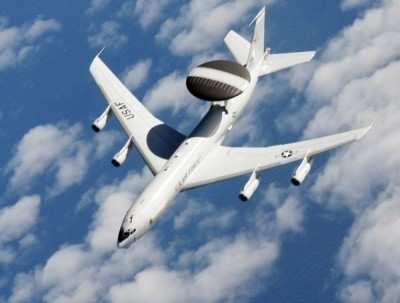Identified Military And Civilian Aircraft With Specific
Information
 A NATO E-3 AWACS took part in
six-hour combat scenarios that demonstrated interoperability
between its prototype interrogator and various joint platforms that
interrogate in the same mode in July, flying at an observation
point 100 miles off the coast of Patuxent River Naval Air Station,
MD.
A NATO E-3 AWACS took part in
six-hour combat scenarios that demonstrated interoperability
between its prototype interrogator and various joint platforms that
interrogate in the same mode in July, flying at an observation
point 100 miles off the coast of Patuxent River Naval Air Station,
MD.
During the multiservice, multinational Joint Operational Test
Approach Operational Assessment, a combined international E-3 team
-- led by a Hanscom Air Force Base 635th Electronic Systems
Squadron team-- had the opportunity to test the interrogator in a
genuine multiservice environment.
A team from the 635th ELSS, the Electronic Systems Center team
responsible for test and development of the aircraft's Mode
5-capable UPX 40 Interrogator, was among Air Force, Army, Navy and
Marine Corps participants there to test their respective
interrogators and transponders.
"We were able to demonstrate interoperability with all the
players in this exercise, which is one of the reasons why we
participate in these JOTA events," said Capt. Will Williams, the
Next Generation Identification Friend or Foe program manager.
The E-3 is an aircraft with integrated command and control,
battle management, surveillance, target detection, and tracking
capabilities and provides an accurate, real-time picture of the
battlespace to the joint air operations center. The aircraft's
interrogator radiates a waveform, using different modes, to
determine information such as aircraft identification and altitude
and also determines if aircraft are friends or foes -- known as
Identification Friend or Foe capability. The E-3 interrogator
enables both military and civilian aircraft to be identified with
range, bearing, and elevation information, along with providing
platform-specific information.
The new Mode 5 capability is a waveform to which the Defense
Department and NATO forces are now transitioning, as outlined by a
Joint Requirements Oversight Council mandate.
"You have specifications that are out there, but everyone
interprets them differently," Captain Williams said. "Each vendor
looks at the specs differently, so it makes it more difficult to
know if they will come together and work."
According to the captain, that is why the event was so
important: to determine the gaps and adjust accordingly.
At designated times, a Navy destroyer would push out, the NATO
E-3 would launch and Navy F/A-18 Hornets and Air Force F-15 Eagles
would spread to different altitudes to test the surveillance and
identification abilities of the ship and E-3. Later, Army UH-60 and
MH-60 helicopters and Marine Corps attack helicopters would take
off and follow a similar route.

AWACS Photo Courtesy U.S. Air
Force
The intent was to get as many Mode 5 platforms as possible in
the area to determine whether it caused Mode 5 transmission
interference.
"We were there to prove that the electronic handshakes between
interrogators and transponders could use very secure cryptologic
code," said Chris Cross, an E-3 international program facilitator.
"The AWACS was able to follow each target as it crossed over others
without the target displays being blended and lost for any period
of time."
Beyond proving interoperability, the event was key in
determining if Mode 5 was correctly identifying other participating
platforms as friends or foes, Captain Williams said. Codes make the
radar secure in order to firmly establish whether a platform is
friendly or otherwise, and program managers encountered challenges
during initial ground testing transmitting these designators.
With the help of Danny Lopez, a Cryptologic Systems Group member
from Lackland AFB, Texas, the codes were able to be modified on the
spot for better operations.
"Without that support, it might have taken a while to figure out
what was going on," Captain Williams said.
Lessons learned from this event will also provide input and
exposure that will contribute to the final production phase of the
interrogator's development.
 Airborne 04.16.24: RV Update, Affordable Flying Expo, Diamond Lil
Airborne 04.16.24: RV Update, Affordable Flying Expo, Diamond Lil ANN's Daily Aero-Term (04.20.24): Light Gun
ANN's Daily Aero-Term (04.20.24): Light Gun Aero-News: Quote of the Day (04.20.24)
Aero-News: Quote of the Day (04.20.24) Aero-News: Quote of the Day (04.21.24)
Aero-News: Quote of the Day (04.21.24) ANN's Daily Aero-Term (04.21.24): Aircraft Conflict
ANN's Daily Aero-Term (04.21.24): Aircraft Conflict




